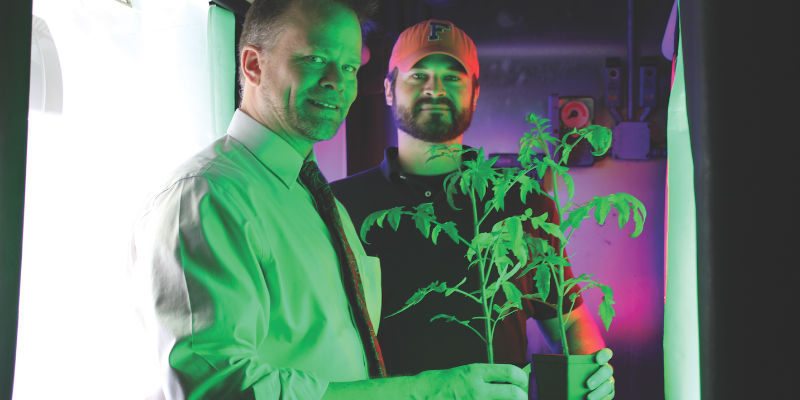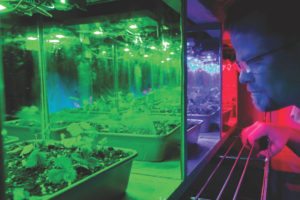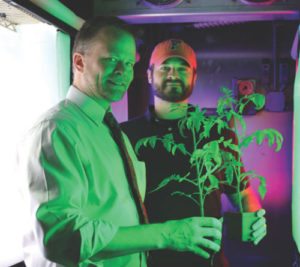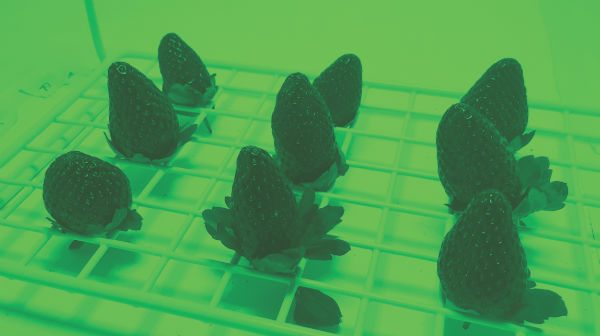
Potential of LEDs Expected to Extend Well Beyond Production
Much of the research and trade press coverage related to light emitting diodes (LEDs) applies to their use with controlled environment agriculture, including greenhouse and vertical farming production. However, LEDs are also being studied for their potential to improve the qualities of field-grown fruits and vegetables. The LEDs are being used on fruit and vegetables after the produce is harvested.
Improving Postharvest Life
Kevin Folta, professor and chairman of the Horticultural Sciences Department at the University of Florida in Gainesville, says researchers are beginning to understand how light can regulate specific plant responses.
“We’ve known for a long time that light can affect photosynthesis,” Folta says. “It’s no big surprise that light can also manipulate something like flavors or any other aspect of plant metabolism.
“We have learned a lot about how we can apply LED light in a postharvest context. After we harvest some plant product, especially crops like tomatoes, blueberries and strawberries, we can affect flavors and shelf life.”
Folta says University of Florida researchers are particularly interested in the effects LEDs can have on the state’s high value crops.

“This includes crops like strawberries and tomatoes and other perishable crops,” he says. “How can we add more value, appeal and nutrition to crops like greens, including lettuce? How we can change the flavor of herbs? We are thinking about all of these crops.”
With funding provided by USDA, Folta, plant biotechnology professor Thomas Colquhoun and plant scientist Sofia Carvalho are looking at many aspects of postharvest quality, including color retention, postharvest breakdown, flavor and nutrients. Folta says research has verified that consumers can taste the difference in select fruits that have been given postharvest treatments with LEDs.
“We also know LEDs can change the levels of color pigments in tomatoes, strawberries and blueberries,” he says. “We know the levels of glucosinolates, which are anti-cancer compounds, can be changed with LEDs. We are able to moderate their levels in crops like brassica sprouts, broccoli sprouts and other cruciferous seedlings. There has also been a lot of research done by me and other people with altering the flavor of basil and cilantro with LEDs.”
Folta says they are working primarily on the impact LEDs can have on field-grown tomatoes and strawberries.
“One of the challenges is how a grower, retailer and even a consumer can enhance the quality of high-value fruits and vegetables after they have been harvested,” he says. “A grower spends the time and money on labor and inputs
like fertilizer to grow, harvest and ship a crop. Is it possible for a grower to use an inexpensive, non- chemical treatment to enhance the life of that product?
“We would like to find ways to use light as a treatment to extend the postharvest life of those products and possibly improve their flavor and/or nutrition. The goal is to make them last longer.”
Folta says multiple LED treatments may be used to improve the postharvest life of the fruit.
“There may be an LED treatment that is done immediately after harvest by the grower and then a second treatment at retail,” he says. “Putting fruit out on the store shelf under white fluorescent light is not the best way to maintain the integrity of the fruit. The grocery stores of the future may put strawberries in a display cabinet that is illuminated with a dim blue LED light so the fruit can last longer. This may involve giving fruit different treatments at retail.”
Results from the LED research may change how grocery stores display their produce in the future.
Exposing some types of fruit, like strawberries, to LED light after harvest has the potential to improve postharvest quality. Photos: University of Florida
LEDs may eventually be used by retailers to improve the postharvest quality of the produce they sell.
Varying Effects on Fruit
The first experiments Folta performed on harvested fruit were conducted in carefully controlled environments.
“We did not test whether the flavor of the fruit could be changed while still on the plant,” he says. “That is a whole different kind of test and there are also environmental variables involved. When you’re growing a crop in the field, anything can happen.
“Which wavelengths have the biggest impact depends on the type of fruit and even the variety. There are no real hard rules. That’s what makes the research so difficult. We have seen some trends. But we are in the infancy of dissecting them.”
Not all crops that have been exposed to LEDs have been shown to benefit from light treatments.
“Changing the flavor of blueberries is not easy to do,” Folta says. “We’ve found that tomatoes and strawberries seem to be a little more flexible in their response. Blueberries don’t really care.”
Citrus is another high-value Florida crop that has shown little response to LED light exposure.
“Citrus fruit like oranges and grapefruits go through a process called degreening when a grower is trying to get them to ripen,” Folta says. “The process is to remove the green color and bring out the orange or yellow colors. We tried using LEDs to accelerate the degreening process. It didn’t work for the small number of tests that we ran. We have a limited amount of resources, both the personnel conducting the research and the available light sources. We have to pick and choose what we are going to trial.”
Not Expecting Big Changes
Folta says he and his colleagues are still in the discovery phase with their LED research.

“We are just trying to understand the phenomenal role and if it is reproducible,” he says. “Once we know that a good effect is caused by a specific wavelength of light we can go back and look at the mechanism. For instance, how are we using light to reduce the sensitivity of the fruit to ethylene? This may be the result of changing a plant receptor or changing a part in the ethylene signal in the plant. This could alter the circadian clock so that maybe the plants are not counting the days. We know that this is controlled by light.
“LEDs can only bring out what is in the plant genetics. It is unlikely that LEDs will be able to confer really big changes. We are probably looking at being able to add a day or two to the shelf life of the produce. I don’t know if a grower will be able to change a variety that just doesn’t have the genetic capacity to survive for days. What we are doing with LEDs is tweaking what is already there genetically.”
Folta says even if the shelf life of a crop can only be extended a short time that could still have a big impact on the crop.
“If the shelf life of a carton of strawberries is extended an additional 24 hours, the savings to grocery stores and the amount of food wasted by consumers would be radically changed,” he claims. “I am fired up about even a small change because that would be a really big step forward. What we are doing is manipulating the plant metabolism or changing it in ways that we don’t necessarily understand 100 percent yet, but we know we can do it.”
For more information: Kevin Folta, University of Florida, Horticultural Sciences Department; www.arabidopsisthaliana.com. Folta hosts the Talking Biotech podcast at www.talkingbiotechpodcast.com.





 Video Library
Video Library 




















